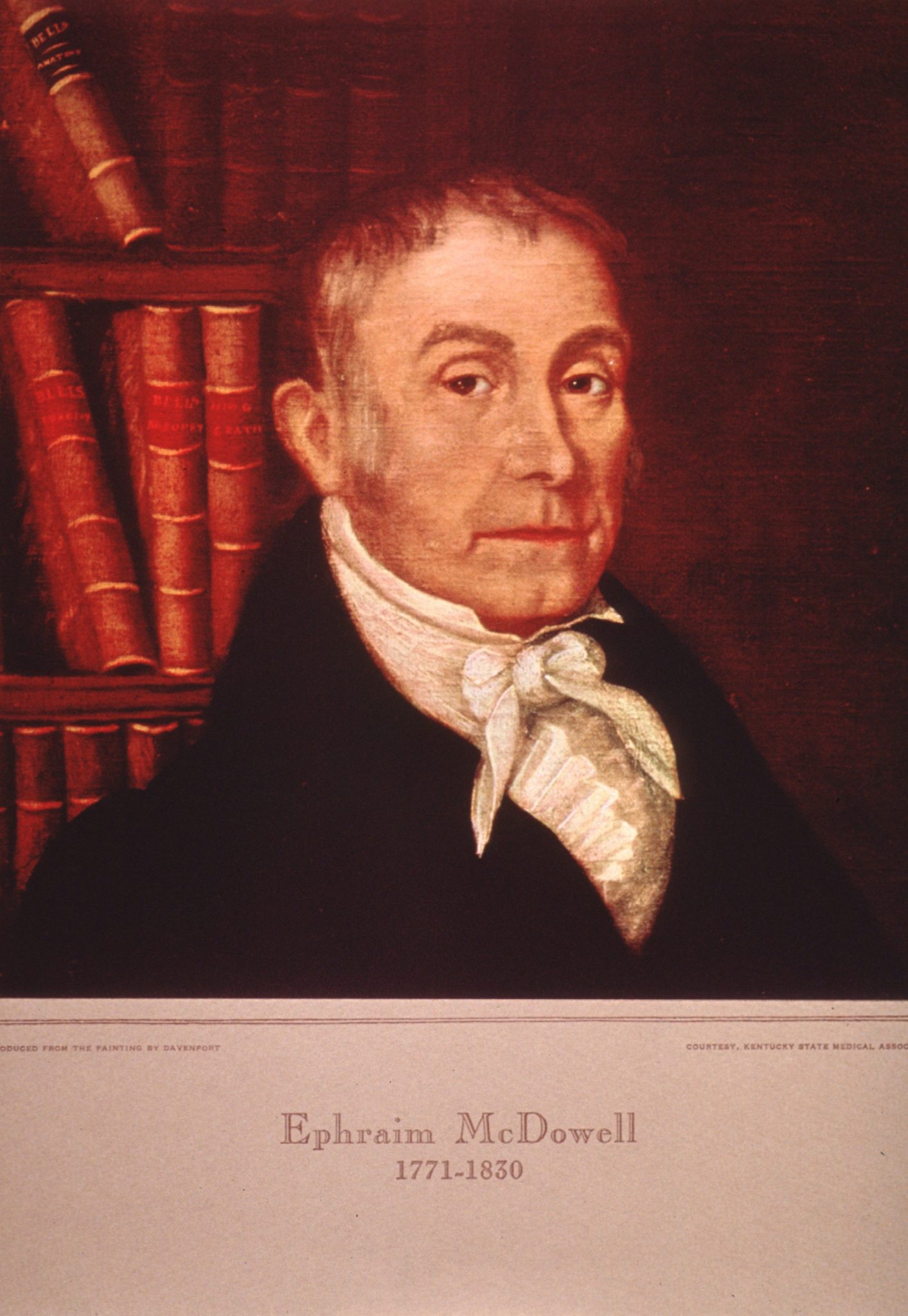John Raffensperger
Fort Meyers, Florida, United States
 |
| Portrait of Ephraim McDowell. Unknown date, published before 1900. National Library of Medicine. |
In 1809, Jane Crawford’s physicians thought she had an overdue pregnancy and called Ephraim McDowell, who lived sixty miles away in Danville, Kentucky.1 McDowell diagnosed an ovarian tumor and advised surgery.
McDowell had been born in Virginia, but his family moved to Danville, Kentucky. He served a medical apprenticeship for three years and in 1793 went to the University of Edinburgh where he studied with John Bell, a distinguished surgeon.
He returned to Danville and developed a busy practice that included amputations, tracheotomies, operations for strangulated hernia, and perineal lithotomies for bladder stones. Unlike surgeons who operated in a blood-stained frock coat, McDowell was “scrupulously clean,” compassionate, and competent.2
McDowell insisted that Mrs. Crawford journey to Danville for the operation, which he did on Christmas day, 1809. She was forty-five years old at the time.
“The day having arrived and the patient being on the table, I marked with a pen the course of the incision to be made. Desiring him, [his assistant] to make the external opening, which in part he did. I then took the knife and completed the operation.”
The tumor was too large to be delivered from the abdomen, so after ligating the Fallopian tube, he cut into the ovary, drained fifteen pounds of a dirty gelatinous material, and then removed the tumor. Dr. McDowell tipped his patient to her side to drain blood, then closed the abdomen with interrupted sutures and adhesive tape. She lived to the age of seventy-eight years.
In 1817, McDowell operated on his second case, a woman who came to him from a distance. There was considerable bleeding and at the end of the operation, she complained of cold and chilliness. McDowell gave her laudanum and cherry bounce, a mixture of brandy and cherry juice. She recovered.
A third woman, from another county, had suffered from pain and distention for eighteen months following a pregnancy. Her physicians and McDowell thought she had ascites. He tapped her and removed thirteen quarts of fluid. Two months later he again removed viscid fluid and made the diagnosis of an ovarian tumor. During the operation, he encountered bleeding, adhesions, and sixteen quarts of fluid within the abdomen and the ovary. She died on the third post-operative day. The cyst contained hair and bone, typical for a cystic teratoma that may have ruptured during the pregnancy, causing chemical peritonitis. Her death was likely due to her advanced, chronic illness.
By 1819, Dr. McDowell had performed five laparotomies for the removal of ovarian tumors.3,4
His fame spread, and in 1822 he removed an ovarian tumor from the wife of General Overton, who had been an officer in the Revolutionary war. Mrs. Overton, who was fifty-five at the time of the operation, lived to the age of seventy-seven years.5
In a letter written in 1829 to a medical student, McDowell said that he had operated on eleven patients and had lost only one.6 Ephraim McDowell died the next year. On the 150th anniversary of his operation on Jane Crawford, the post office issued a commemorative stamp in his honor.
References
- Haggard, WD, Surgeon of The Wilderness—Ephraim McDowell; Surgery, Gynecology and Obstetrics, 1934, 58, 415-419
- Otherson, HB, Ephraim McDowell, The Qualities of a Good Surgeon; Annals of Surgery, 2004,239,[5], 648-650
- McDowell, E., Three Cases of extirpation of diseased ovaria; Eclectic Repertory and Analytical Review. 1817, 7, 242-244 [Pub Med, Google Scholar]
- McDowell, E. Observations on Diseased Ovaria, Eclectic Repertory and Analytical Review 1819; 9, 546 [Google Scholar]
- Ikard, R.I., Ephraim McDowell’s Ovariotomy on General Overton’s Wife; American Surgeon, 2016, 82, [4] 291-294
- Letter to Robert Thompson, written on January 26, 1829. Provided by the McDowell Museum, Danville Kentucky
JOHN RAFFENSPERGER, MD, graduated from the University of Illinois College of Medicine in 1953, interned at the Cook County Hospital, spent two years in the Navy and returned to Cook County for training in general, thoracic, and pediatric surgery. He was on the attending staff at Cook County until 1970, when he went to the Children’s Memorial Hospital and eventually became the surgeon in chief. He has written textbooks, works of medical history, and novels. After retiring from active practice, he sailed across the Atlantic and back, then served as a voluntary pediatric surgeon at Cook County.

Leave a Reply